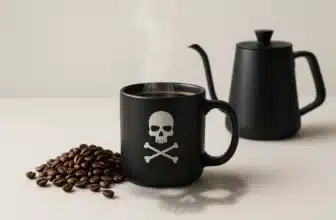
One Hundred Coffee is reader-supported, and some products displayed may earn us an affiliate commission. Details
Old Coffee Grounds: What They Are and Why They Matter
When we talk about “OLD COFFEE GROUNDS,” we typically refer to used coffee grounds that have already been. These are the wet, compacted remnants left in your coffee machine, French press, or espresso portafilter after you’ve made your cup of coffee. They’ve already given up most of their soluble flavor compounds to your brew. What’s left is a dense clump of organic material that’s mostly spent, though it can still have various uses beyond your morning cup.
But “old coffee grounds” can also mean pre-ground coffee that’s been sitting around too long, either before or after opening the bag. Once coffee beans are ground, they begin losing freshness quickly due to exposure to air, light, and moisture. Oxygen starts breaking down the oils and aromatic compounds, and in just a few days (or hours, depending on storage), that bright, bold flavor fades. Old pre-ground coffee often tastes flat, bitter, or stale, even if it hasn’t technically gone “bad.”

Who is this for?
Cameron’s Toasted Southern Pecan is for flavored coffee fans who crave a rich, nutty taste without bitterness. Small-batch roasted and smooth, it’s ideal for drip machines and pour-over lovers. A great choice for those who enjoy comforting aromas and mellow flavor in every cup—perfect for cozy mornings or dessert pairings.
Price on AmazonUsed Grounds vs. Stale Grounds
It’s helpful to separate the idea of “used” grounds (post-brew) from “stale” or “aged” grounds (pre-brew). Used grounds aren’t useful for drinking again — the flavor is gone — but they’re rich in nitrogen and make great additions to compost piles, garden soil, or even DIY beauty scrubs.
Stale grounds, on the other hand, are a brewing problem. If you’re using old ground coffee that’s been sitting in your cupboard for a month or more, your coffee will likely taste off. It’s not unsafe to drink, but it won’t be enjoyable.
How to Know If Coffee Grounds Are Old
Here’s our detailed guide: How to Know If Coffee Grounds Are Old
Why This Matters More Than You Think
Whether you’re a coffee aficionado or just someone who enjoys a comforting cup in the morning, one thing is universally true: freshness makes all the difference. You could have the fanciest coffee gear in the world, but if your grounds are stale, you’ll still end up with a flat, disappointing brew.
So, how do you know if your coffee grounds are past their prime? This guide will walk you through everything you need to recognize, prevent, and manage old coffee grounds — all in a friendly, easy-to-understand way.
What Happens When Coffee Grounds Age?
Freshly ground coffee is a magical thing. It smells vibrant, earthy, maybe even a little fruity or floral, depending on the bean. But over time, that magic fades.
Oxidation Is the Culprit
The main enemy here is oxygen. Once coffee is ground, it exposes more surface area to air, causing essential oils and aromatic compounds to break down.
What You Lose:
- Flavor complexity
- Aromatic intensity
- Crema production (for espresso)
Old grounds = dull, bitter, lifeless brews. And no one wants that.
7 Signs Your Coffee Grounds Are Old
1. The Aroma Test
Fresh coffee smells irresistible. If your coffee has little to no smell or smells stale (think cardboard or ash), it’s probably past its best.
2. Taste Tells the Truth
- Fresh: Bright, flavorful, balanced.
- Stale: Flat, bitter, sour, or hollow.
If you find yourself reaching for cream and sugar to “fix” the taste more than usual, that’s a red flag.
3. Visible Changes
- Clumping: If your grounds stick together like damp sand, they might have absorbed moisture.
- Dull color: They should be deep brown; if they look ashy or faded, they’re likely oxidized.
4. Brew Behavior
- Lack of bloom: In a pour-over or French press, fresh coffee will bubble and puff up when hot water hits it.
- Slow extraction: Old grounds can clog filters and slow down brewing.
5. Static Cling Is Missing
Weirdly enough, when coffee grounds are fresh, they often cling to your grinder or container due to natural oils. If they feel dusty and dry, it’s a sign of age.
6. Dry, Lifeless Texture
Rub a pinch between your fingers. Fresh coffee feels slightly oily. Old coffee? Dry as desert sand.
7. Time Passed
The golden rule? Once ground, coffee starts losing freshness within 15 minutes. If you’ve had that bag open for more than 2 weeks, it’s probably aging fast.
How Long Do Coffee Grounds Last?
Let’s break it down:
Whole Beans (Unopened):
- 6-9 months in a vacuum-sealed bag
- Up to 12 months in the freezer (though quality drops slightly)
Ground Coffee (Opened):
- 1-2 weeks for peak freshness
- 1 month max if stored properly
Ground Coffee (Unopened Store-Bought):
- Up to 3-5 months if vacuum sealed
Ground Coffee (In Fridge or Freezer):
- Can last up to 3 months, but risks moisture absorption
Best Storage Practices to Keep Grounds Fresh
If you want your grounds to stay fresh longer, follow these rules:
1. Use an Airtight Container
Forget those roll-top bags with plastic clips. You want a vacuum-sealed, airtight container, ideally made from stainless steel or dark ceramic.
2. Avoid Light, Heat, and Moisture
Keep your coffee away from windows, stovetops, and anywhere humid. The ideal environment is cool, dark, and dry.
3. Don’t Store in the Fridge
Contrary to old myths, fridges add moisture, which ruins coffee. Unless you have a vacuum-sealed fridge storage system, avoid it.
4. Freeze in Batches (Optional)
If you must freeze coffee, divide it into small single-use portions to avoid temperature swings. Always let it return to room temperature before opening.
5. Grind on Demand
This is the #1 way to keep things fresh. If possible, invest in a burr grinder and only grind what you need per cup.
What To Do With Old Coffee Grounds (Don’t Toss Them Yet!)
Just because they’re not great for drinking doesn’t mean they’re useless. Here are some clever ideas:
1. Natural Deodorizer
- Place them in the fridge, freezer, or trash can to neutralize odors.
2. Fertilizer & Compost
- Coffee is rich in nitrogen. Great for compost piles or mixing into garden soil.
3. DIY Scrubs
- Mix with coconut oil or honey to create a skin exfoliant.
4. Bug Repellent
- Scatter around plants to deter ants and slugs.
5. Cleaning Abrasive
- Use it to scrub pots, pans, or grills without chemicals.
How to Keep Your Coffee Game Strong
Here are some daily and weekly tips that I follow to stay ahead of coffee spoilage:
Daily Tips
- Grind fresh: Even a cheap hand grinder like the Hario Mini or Tuni G1 makes a big difference.
- Seal tightly: As soon as you scoop what you need, reseal that container fast.
- Avoid moisture: Don’t use a wet scoop or leave it near the sink.
Weekly Tips
- Smell check: Give your coffee a sniff once a week. You’ll get used to spotting the scent of staleness.
- Rotate stock: First in, first out. Always.
- Recalibrate brew methods: If taste shifts, your beans might be aging.
Myth-Busting Time
Let’s bust a few common myths about old coffee grounds:
Myth 1: “Coffee never expires.”
Wrong. While it won’t make you sick, old coffee loses all the good stuff that makes it worth drinking.
Myth 2: “If it looks okay, it’s fine.”
Not true. Flavor and aroma loss isn’t always visible. Trust your nose and taste buds.
Myth 3: “You should store it in the fridge.”
Nope. Fridges are humid. Coffee is porous. You’ll ruin the flavor and introduce moisture.
Myth 4: “Buying pre-ground is just as good.”
Freshly ground beans win every single time. No debate there.
Chapter 8: Freshness Timeline & Quick Reference Chart
| Coffee Type | Peak Freshness | Acceptable Range | Storage Advice |
|---|---|---|---|
| Whole Beans | 2-3 weeks post-roast | Up to 6 weeks | Reseal in an airtight container |
| Ground Coffee | 15 minutes post-grind | Up to 2 weeks | Grind fresh whenever possible |
| Store-Bought Ground | Upon opening | 1 month max | Freeze in small portions. |
| Frozen Coffee | 3 months max | Freeze in small portions |
Final Thoughts: Freshness Is the Secret Ingredient
You don’t have to be a coffee snob to enjoy a better brew. One of the simplest ways to elevate your morning cup is to pay attention to your grounds. Knowing how to spot old coffee, how to prevent it, and what to do if it happens can genuinely transform your routine.
Fresh coffee just tastes better, smells better, and makes your day start on the right note.
So next time you scoop from the bag, take a moment. Inhale. Feel the texture. Taste with intention. Because once you experience truly fresh coffee, there’s no going back.






